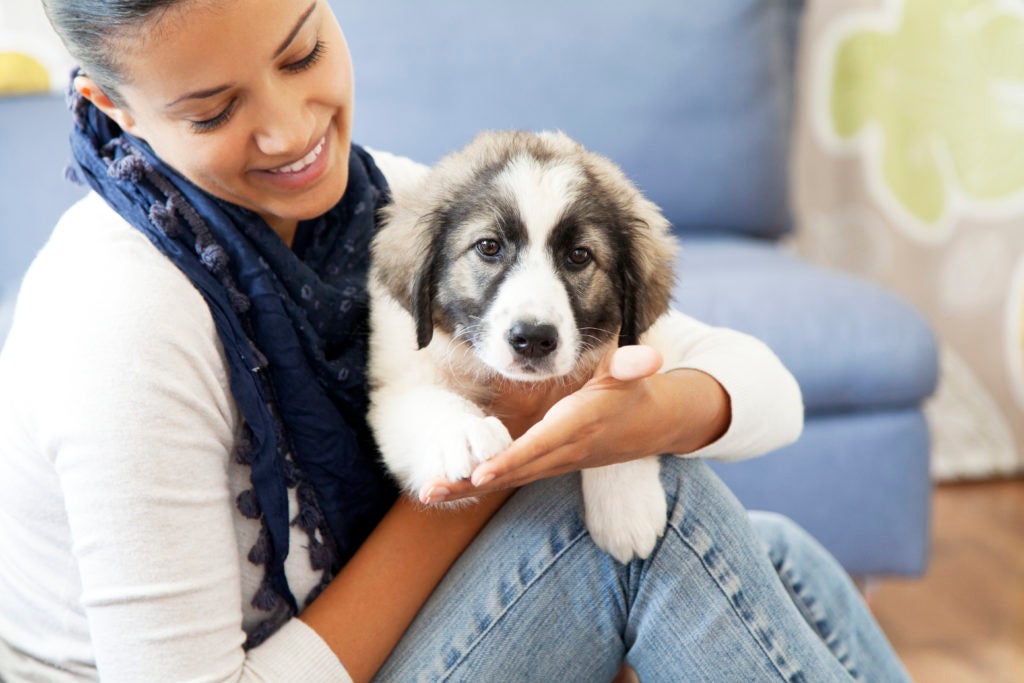
Bringing home a new pet is one of life’s most exciting experiences and many Americans appear to agree — 68 percent of households in the United States own a furry companion, according to the American Pet Products Association’s National Pet Owners Survey. Recognizing that our pets are important to us, some companies are now offering their employees “pawternity” leave (also known as “furternity” leave).
Pawternity leave allows new pet owners to take time off from work to get their newest four-legged family member settled into a new home and routine. Even if your company doesn’t offer this perk, you might still want to consider taking time off due to the many benefits that spending uninterrupted time with your new arrival can provide.
How Much Pawternity Leave to Take
The amount of pawternity leave you take may depend on your situation and your company’s policies. Dr. Jerry Klein, DVM and Chief Veterinary Officer at AKC recommends that “the rescue or purchase of a new family member should ideally be made when there is adequate time to train and bond with the new family member — at least five to seven days.” This time is vital to teach your dog his new mealtimes, potty breaks, and acceptable behaviors.


Health Benefits of Pawternity Leave for Dogs
One of the first things you should do when you get a new dog is bring the pup to a veterinarian for a check-up. Pawternity leave allows you time to do that without having to fit an appointment in around your work schedule.
A veterinary consultation is important because it gives you a chance to ask questions about your dog’s behavior, potential health problems, and past medical history. “With your veterinarian, on the first exam, you should bring in a fecal sample to rule out any parasites, and previous vaccination and health records, which you should have received from the breeder or rescue,” recommends Dr. Klein.
You’ll also have plenty of time during your pawternity leave to monitor your dog’s behavior for any signs of health issues and address them right away. If you notice anything is amiss, be sure to discuss your dog’s health with your veterinarian and breeder or rescue organization. “They have familiarity with your dog’s breed temperament, exercise requirements, grooming requirements, and growth concerns,” says Dr. Klein.
Mental Benefits of Pawternity Leave for Dogs
One of the main benefits of taking pawternity leave is the time it allows your dog to adjust to a new environment with you around for emotional support. “Coming into a new home is a huge life event for a dog, whether you’re bringing home a new puppy or an older rescue dog,” says Sarah Fraser, cofounder of Instinct Dog Behavior & Training. “Having their new human around to show them the ropes can go a long way in building a strong, trusting relationship.”
During pawternity leave, you can teach your dog basic things he’ll need to know — like his name, the places he’s allowed in your home, his potty spot, his crate, and his feeding times. You can also socialize him with other pets in the household and other dogs in general if he’s had all of his vaccinations.
Keep in mind that while training is important, especially for puppies, bonding is the primary thing to focus on during your pawternity leave. “If you’re taking time off from work, focus less on teaching new skills and more on building a relationship and on getting to know your new friend, including their likes and dislikes,” recommends Fraser. Remember, this initial bonding period is important because dogs form their attachment to humans much like human toddlers do, according to a 2018 study published in Attachment and Human Behavior.

Companies That Offer Pawternity Leave
The concept of pawternity leave is catching on with more and more employers. A recent survey conducted by Nationwide and the Human Animal Bond Research Institute (HABRI) found that 91 percent of employees who work for companies with these types of pet-friendly policies are more engaged with their work.
Zogics of Lenox, MA has a pawternity leave program and offers other benefits like discounts on pet insurance and a pet-friendly office. “Every day is take your dog to work day at Zogics [Pet Division], and more than half of our employees bring their four-legged friends to office,” says CEO Paul LeBlanc. It’s because of policies like this that Zogics was recently named one of the Best Workplaces in America by Inc Magazine.
BounceX, an international marketing technology company with offices in New York and London gives employees two days of paid pawternity leave that new pet owners can use immediately following a pup’s arrival to the family. In addition, the company gives new owners a $250 Amazon gift card for the purchase of pet-related items.
The Importance of Pawternity Leave
Even if your company doesn’t offer paid or unpaid pawternity leave, consider taking a few vacation days off when you bring home your new pup. Or, inquire with your employer about whether you can work from home during your first week with your new dog.
New pup owner Kassi McCombe, who works here at AKC, was able to take two days of paid pawternity leave and worked from home for three days during her first week with puppy Bennett, a 10-week-old Brittany. This allowed her to properly potty train her new arrival and get him used to crate training.
“We didn’t do too much training in the first few days, mostly working on ‘sit,’ ‘no biting,’ and learning his name,” says McCombe. “We started working on potty training from the start, which meant we took a lot of trips outside to go to the bathroom and help him learn where he was supposed to go — but never scolded him when he did have an accident in the house — which was very often those early days.”
Asked if she would do it again, McCombe gave an enthusiastic yes. “It was very important to me to be able to devote those days to our relationship and making sure he was comfortable, safe, and well-adjusted to his new home and routine — I’m not sure I’d do it any other way!”


